Installing an outdoor sink near your grill dramatically enhances food safety by providing immediate access to wash hands after handling raw meat and rinse fresh produce on-site. You’ll streamline your cooking workflow, eliminating constant trips to your indoor kitchen while maintaining a clean, organized workspace. The sink enables real-time cleanup of utensils and surfaces, preventing bacteria buildup and cross-contamination. This upgrade transforms your grilling area into an efficient outdoor kitchen that’ll elevate your entire cooking experience.
Enhanced Food Safety and Hygiene During Grilling
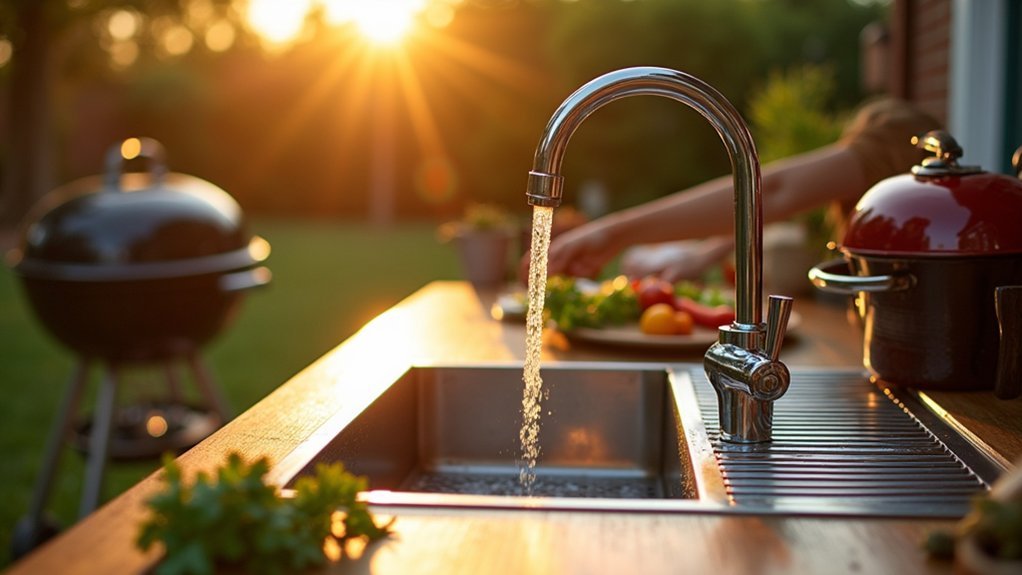
When you’re grilling outdoors, maintaining proper food safety becomes considerably more challenging without convenient access to running water. An outdoor sink transforms your grilling experience by providing essential hygiene capabilities right where you need them most.
You’ll wash hands immediately before and after handling raw meat, preventing dangerous cross-contamination. Food preparation becomes safer when you can rinse fruits and vegetables on-site, removing dirt and pesticide residues.
Your utensils and grilling accessories get cleaned instantly, eliminating bacteria buildup that typically occurs when tools sit dirty. This dedicated washing station maintains overall cleanliness throughout your cooking session, ensuring food safety protocols are followed consistently.
The convenience encourages proper hygiene practices that might otherwise be skipped during outdoor cooking.
Streamlined Workflow for Outdoor Cooking Sessions
An outdoor sink transforms your grilling area into an efficient food prep station where you can rinse vegetables, clean cutting boards, and prepare ingredients without stepping away from the heat.
You’ll maintain perfect timing on your grilled items while seamlessly shifting between prep tasks and cooking.
The nearby water source creates a seamless cleanup process that keeps your workspace organized and eliminates the back-and-forth trips to your indoor kitchen.
Efficient Food Prep Station
Since efficiency drives every successful outdoor cooking session, positioning a sink near your grill transforms your backyard into a streamlined food prep station.
You’ll eliminate constant trips indoors for washing hands between handling raw meats and vegetables, maintaining proper food safety standards. This outdoor sink setup creates a dedicated workspace where you can rinse fresh produce, clean barbecue tools, and organize ingredients without leaving your cooking zone.
The immediate access to water enhances your outdoor kitchen’s functionality, allowing quick clean-up of spills and sanitizing surfaces.
You’ll maintain better organization throughout your cooking experience, keeping prep areas tidy while focusing on grilling perfection. This integrated approach transforms ordinary backyard cooking into an efficient, professional-grade food prep operation that maximizes both safety and convenience.
Seamless Cleanup Process
Beyond streamlining your prep work, an outdoor sink revolutionizes your cleanup process by creating a dedicated washing station right where the mess happens. You’ll maintain cleanliness effortlessly while washing utensils, cutting boards, and grill tools without interrupting your cooking experience. This seamless flow between food preparation and cleanup keeps your organized outdoor area functioning smoothly.
| Cleanup Task | Without Outdoor Sink | With Outdoor Sink |
|---|---|---|
| Washing utensils | Multiple indoor trips | Immediate cleaning |
| Sanitizing surfaces | Delayed cleaning | Real-time maintenance |
| Managing spills | Paper towels only | Water access available |
| Tool organization | Cluttered grill area | Clean, organized space |
The strategic placement near your grill creates an efficient work triangle, enhancing efficiency by allowing you to clean as you cook rather than facing a overwhelming mess afterward.
Essential Plumbing and Installation Considerations
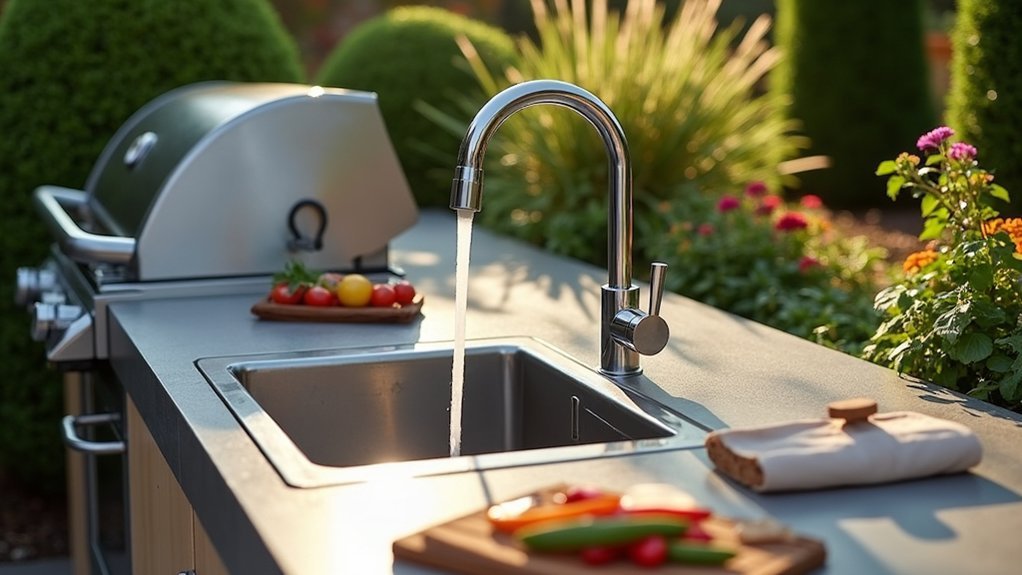
When you’re planning an outdoor sink installation near your grill, you’ll need to tackle several critical plumbing requirements that can make or break your project’s success.
First, guarantee you’ve got proper access to water supply lines and drainage systems for seamless connections. Check local plumbing codes and secure necessary permits, as regulations vary for outdoor kitchen sinks connected to sewer or septic systems.
Position your sink within 20-24 inches of your grill to maximize cleaning efficiency during outdoor grilling sessions. Choose durable materials like stainless steel that’ll withstand harsh weather conditions while remaining easy to maintain.
Consider adding hot water connections for enhanced functionality, though this requires additional plumbing work. Proper installation planning guarantees your outdoor sink becomes a valuable asset rather than a costly headache.
Choosing the Right Sink Size and Material for Your Grill Area
With your plumbing infrastructure planned, you’ll now focus on selecting the perfect sink dimensions and materials that complement your grilling setup.
Choose a larger outdoor sink for enhanced practicality, providing ample space for washing utensils and ingredients without crowding. Stainless steel sinks, particularly 304 grade, offer superior durability and corrosion resistance for outdoor environments.
A double basin configuration maximizes functionality in your grill area, allowing simultaneous washing and rinsing during food preparation. Consider greater depth to accommodate larger pots and cookware.
These durable materials require minimal maintenance while withstanding weather exposure. Evaluate additional features like integrated cutting boards or utensil holders to streamline your cooking workflow and enhance overall efficiency around your grilling station.
Hot Water Vs Cold Water Setup Options
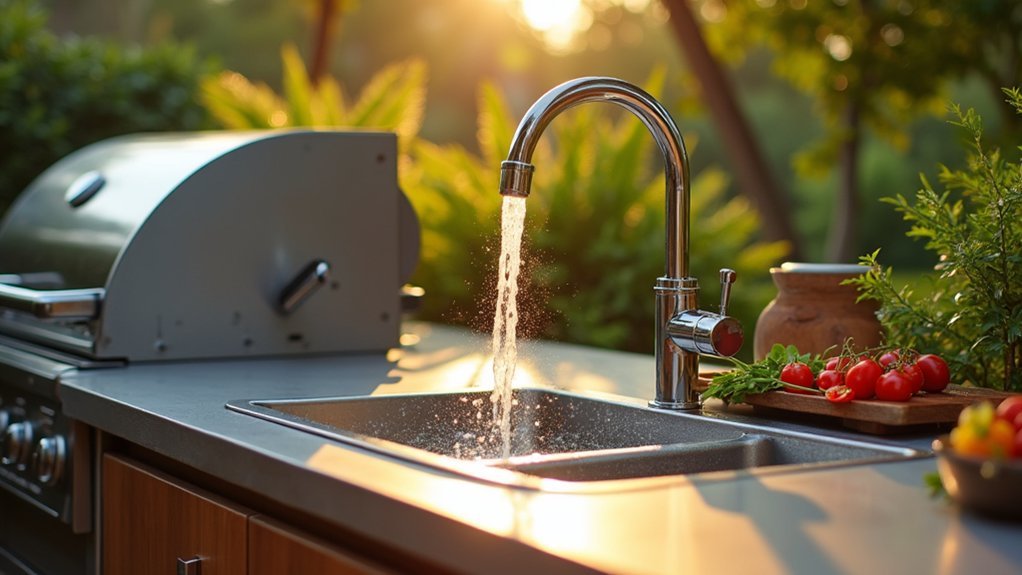
When planning your outdoor sink, you’ll need to decide between a cold water setup or adding hot water capabilities.
Cold water installations offer simplicity and lower costs, while hot water systems provide superior cleaning power for greasy barbecue tools and better sanitation.
Your choice will greatly impact both your installation budget and your outdoor cooking cleanup experience.
Cold Water Benefits
Cold water setups offer significant advantages for outdoor sink installations near your grill. You’ll find these systems simple to install and cost-effective, connecting directly to your garden hose without complex plumbing requirements.
Cold water perfectly handles most outdoor kitchen tasks, from rinsing vegetables to washing hands and cleaning barbecue tools.
Key benefits include:
- Easy installation – No hot water lines or complicated plumbing modifications needed
- Adequate cleaning power – Sufficient for light washing tasks common in outdoor spaces
- Flexible drainage – Wastewater drains into buckets or PVC pipes for easy disposal
While cold water limits sanitization capabilities for heavily soiled items, it’s practical for typical grilling scenarios.
Your outdoor space becomes more functional with this straightforward, easy to clean solution.
Hot Water Advantages
Although cold water serves basic outdoor cleaning needs, hot water transforms your outdoor sink into a truly functional kitchen station.
You’ll achieve superior cleaning and sanitization when tackling greasy pots and pans from your grill. Hot water enhances food safety by effectively washing fruits and vegetables before meal preparation. It enables quick hand rinse after handling raw meat, preventing dangerous cross-contamination during outdoor cooking.
When entertaining guests, hot water adds tremendous convenience for washing drinks and glassware without requiring trips indoors. Your outdoor kitchen becomes more versatile and efficient with hot water access.
While cold water handles basic rinsing tasks, hot water elevates your outdoor sink’s capabilities, making it an indispensable tool for serious outdoor cooking and hosting.
Installation Cost Comparison
The installation costs between hot and cold water outdoor sink setups reveal significant differences that’ll impact your budget planning.
Your cold water sink installation typically ranges from $200 to $1,000, making it the budget-friendly option since it often uses simple hose connections with minimal plumbing systems complexity.
However, your hot water setup increases installation costs by $500 to $1,500 due to additional water heater connections and extensive plumbing requirements.
Consider these key cost factors:
- Water heater expenses: Basic models start at $150, while tankless options exceed $1,000
- Labor complexity: Hot water installations require specialized plumbing work
- Material requirements: Cold water setups need fewer components and connections
Despite higher upfront costs, your hot water outdoor sink delivers long-term savings through efficiency in cleaning and reduced water usage over time.
Maintenance and Winterization Requirements
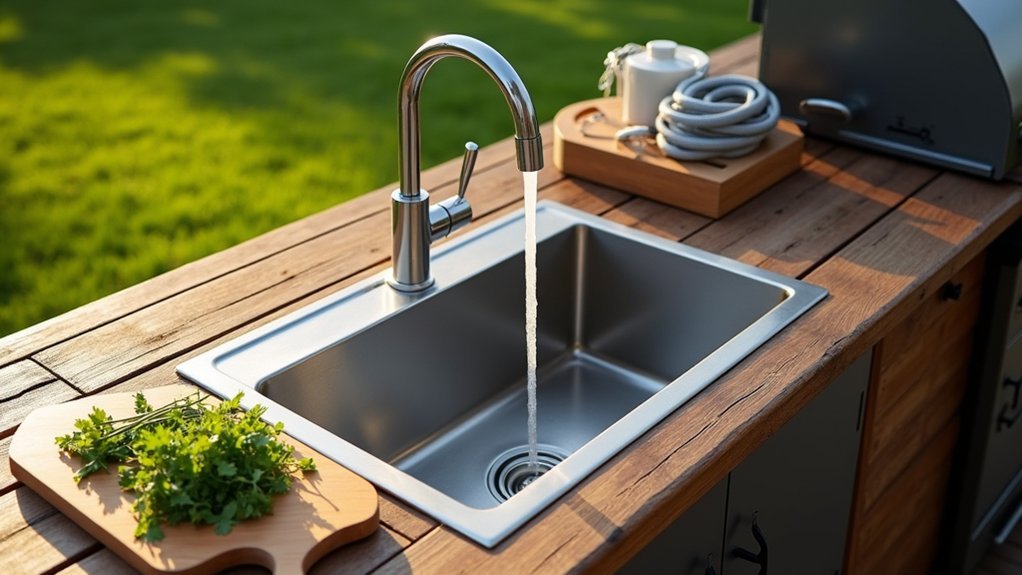
Since your outdoor sink represents a significant investment in your grilling setup, you’ll need to establish a consistent maintenance routine to keep it functioning properly year-round.
Regular maintenance involves cleaning away leaves, pollen, and grime to maintain both functionality and appearance. You’ll want to conduct annual inspections for leaks in fixtures and connections to guarantee clean water flow.
Regular cleaning and annual leak inspections keep your outdoor sink functioning properly and looking great year-round.
Winterization becomes critical in colder climates where freezing issues can cause expensive plumbing work. You must drain your entire water supply system, including all pipes connected to your outdoor sink.
Add insulation around exposed pipes and cover the sink with waterproof materials. If you’ve got hot water lines, shut them off completely and drain thoroughly to prevent costly freeze damage.
Frequently Asked Questions
Should an Outdoor Kitchen Have a Sink?
Yes, you should install a sink in your outdoor kitchen. It’ll enhance functionality by providing convenient hand-washing, ingredient preparation, and cleanup capabilities without disrupting your cooking flow or requiring trips indoors.
Where to Drain an Outdoor Sink To?
You should drain your outdoor sink to a sanitary sewer or septic system to comply with local codes. Alternatively, consider greywater systems for irrigation if regulations permit this option.
How to Keep an Outdoor Sink From Rusting?
Choose high-quality stainless steel, clean regularly with gentle soap, apply protective coating, guarantee proper drainage to prevent standing water, and polish copper sinks with beeswax to prevent rust formation.
Where Should the Sink Be Located?
You should position your sink within 10-15 feet of your grill, near food prep areas. Verify there’s 20-24 inches of counter space on each side for ideal workflow and functionality.
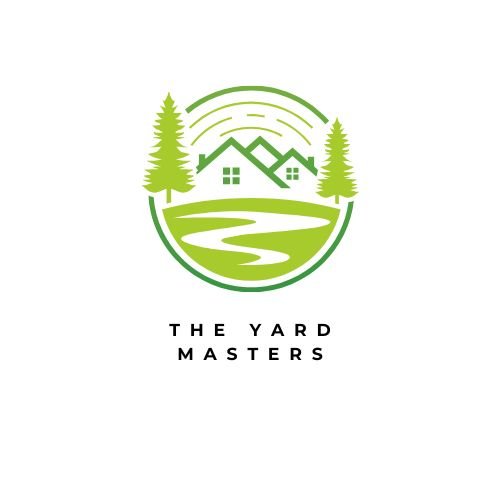
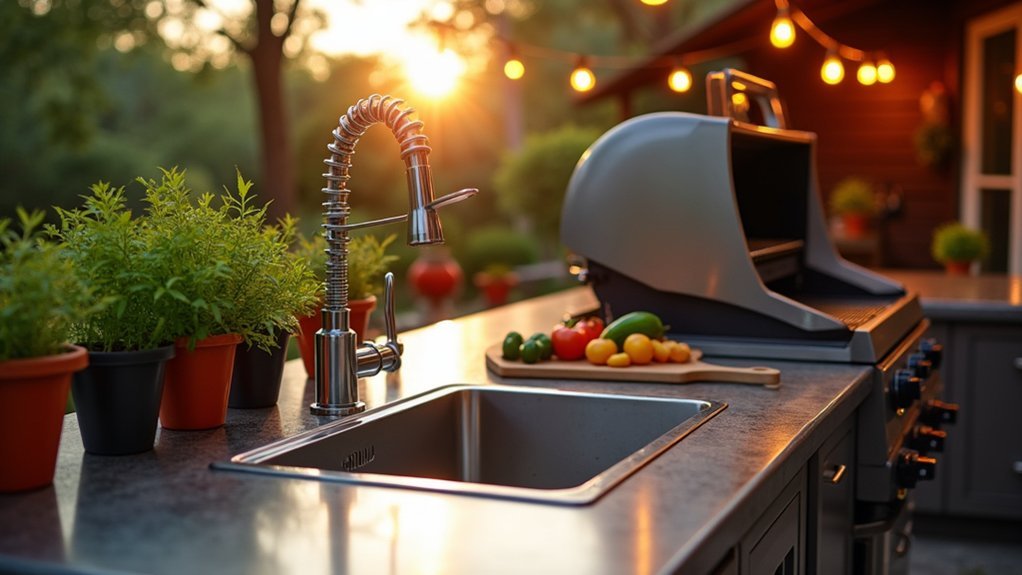


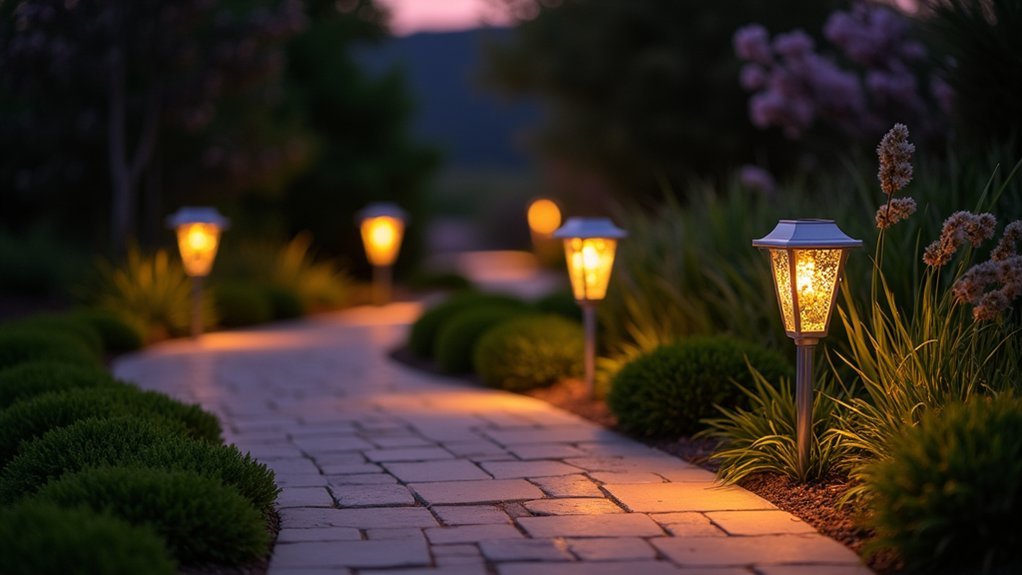
Leave a Reply